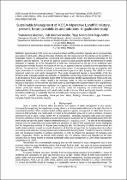| dc.contributor.author | Nabukeera, M. Sebyala | |
| dc.contributor.author | Boerhannoeddin, Ali | |
| dc.contributor.author | Noriza, Raja | |
| dc.date.accessioned | 2020-11-22T07:38:17Z | |
| dc.date.available | 2020-11-22T07:38:17Z | |
| dc.date.issued | 2014-11 | |
| dc.identifier.citation | Madina,N.(2014).Sustainable Management of KCCA Mpererwe Landfill: History, present, future possibilities and solutions. A qualitative study.IOSR Journal of Environmental Science, Toxicology and Food Technology (IOSR-JESTFT).Volume 8, Issue 11 Ver. III, PP 87-95 | en_US |
| dc.identifier.issn | 2319-2399 | |
| dc.identifier.issn | 2319-240 | |
| dc.identifier.uri | http://ir.iuiu.ac.ug/xmlui/handle/20.500.12309/740 | |
| dc.description | Approximately 1500 tonnes are dumped at Kitezi landfill presently in Uganda, due to increased daily generation of solid waste. Although this state of affairs calls for improvement of the practices at the landfill in a sustainable manner to safeguard the environment and uphold public health, the required technology for the landfill is yet to be attained. | en_US |
| dc.description.abstract | Approximately 1500 tonnes are dumped at Kitezi landfill presently in Uganda, due to increased daily generation of solid waste. Although this state of affairs calls for improvement of the practices at the landfill in a sustainable manner to safeguard the environment and uphold public health, the required technology for the landfill is yet to be attained. The aim of this paper is to ascertain and assess the growth and tendencies in landfil utilization in Uganda. In 1970s management of solid was characterized by the use of the traditional open dumping sites normally found in the suburbs of the city, an approach that was suitable since the population was still low. The period from 1986 embraced a decentralized system of management that was accompanied with rapid construction of residential structures and a reduction in spaces for open dumping. This called for a more organized system for solid waste management. Thus waste management became a responsibility of the five divisions under Kampala Capital City Authority. In early1990s, outsourcing of solid waste management services in all divisions of KCCA was witnessed and in 1996 the first sanitary landfill was launched at Kitezi as the only engineered landfill (called ‘Kitezi Landfill’) for municipal waste. In 2005 the landfill became a nuisance because of bad odour, vermin and this was made worse by scavengers who scattered waste in the neighborhood. In 1999 the National environment regulation for Uganda was implemented for municipal waste to enable cleaner production methods, licenses and to devolve power for inspecting the environment. Although implementation of the regulations is yet to yield modest results, it is clear that it was big step towards a positive foundation establishing a sustainable disposal and solid waste management system in Uganda. Key | en_US |
| dc.language.iso | en | en_US |
| dc.publisher | IOSR Journal of Environmental Science, Toxicology and Food Technology (IOSR-JESTFT) | en_US |
| dc.relation.ispartofseries | IOSR Journal of Environmental Science, Toxicology and Food Technology (IOSR-JESTFT);.Volume 8, Issue 11 Ver. III | |
| dc.subject | Landfill Sustainability | en_US |
| dc.subject | Municipal Solid Waste | en_US |
| dc.subject | Backlogs | en_US |
| dc.subject | Privatization | en_US |
| dc.subject | Legal framework | en_US |
| dc.subject | Kampala Capital City Authority | en_US |
| dc.subject | Uganda | en_US |
| dc.title | Sustainable Management of KCCA Mpererwe Landfill | en_US |
| dc.title.alternative | History, present, future possibilities and solutions | en_US |
| dc.title.alternative | A qualitative study | en_US |
| dc.type | Article | en_US |

